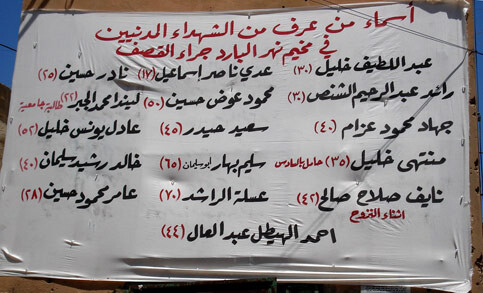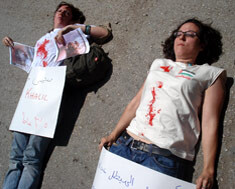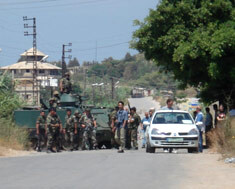Beirut 4 June 2007

Names of the known Nahr al-Bared Refugee Camp residents who have been killed during the Lebanese army’s assault.
We drove up to Baddawi refugee camp Sunday morning at the request of the women of Nahr al-Bared refugee camp who are now among the thousands of internally displaced Palestinians (IDPs) in Lebanon. They asked Lebanese and internationals to join them in a die-in at the southern checkpoint of the Nahr al-Bared refugee camp. We painted our t-shirts with red paint and we made signs in English and in Arabic; each sign had one of the seventeen known names of Palestinians who have died as a result of the Lebanese army’s siege of the Nahr al-Bared camp. The action, which was small but symbolic, began with a march to the entrance of the camp and in the distance we could see black clouds of smoke smoldering. When we arrived there were no soldiers around. We stopped a few meters before arriving at the checkpoint and fell to the ground. As we lay there representing the dead Palestinians from Nahr al-Bared on the hot asphalt I could feel the vibrations of the bombs going off in the camp and I could hear shots being fired from guns. I wondered how much more Palestinian blood would be spilled onto the streets of the camp.
After about fifteen minutes or so the army arrived with about a dozen soldiers and a tank and they took over the position where we had been lying down. The soldiers began harassing us by taking our posters with the names of the dead Palestinians. One of the people in our group, who is Palestinian-Jordanian, was physically harassed by a soldier. Another member of our group, who is Lebanese, was told, “if you were Lebanese I wouldn’t need to teach you nationalism. If you were really nationalist, you would be on the side of the army.” He replied that “there are many Americans who are against the U.S. occupation of Iraq, but they are still nationalist.” From the Lebanese army’s point of view — and from the complicit media’s point of view as well — the only dead who matter are the Lebanese soldiers. These are the people whose names and faces dot the pages of the newspapers, not the Palestinian civilians who remain erased from the reality of this massacre. Because the army is the only body reporting dead or wounded we only count the dead Lebanese, not the dead and wounded Palestinians.
The women from Nahr al-Bared who rode in my car with me to the demonstration today talked with us about the camp and who they know inside. One woman’s husband has been working at the border of the camp and she told us about the people inside and why they have not been able to leave: the handicapped, the elderly, and the sick are those who remain trapped inside — not people who support Fatah al-Islam as the media would have it. Aid still cannot get inside the camp and journalists are still being harassed by the army and are not allowed to shoot any footage — especially video — from any area near the fighting. Although a few ambulances were able to pick up a few people from Nahr al-Bared and take them to the hospital in nearby Baddawi camp, inside there remains far more wounded and dead and we can only imagine how dire the situation will be once the fighting stops and we can witness the devastation.

Participants of the die-in at the southern checkpoint at Nahr al-Bared camp.

The Lebanese army harassed the protesters.
Amidst all of the intensified fighting in Nahr al-Bared — and we saw almost forty military trucks filled with soldiers heading in that direction as we drove back to Beirut — new fighting broke out in Ein al-Helweh refugee camp in Saida in southern Lebanon yesterday. We heard the previous day that 10,000 Palestinians from that camp fled to Saida over the past few days because of fears that they would be next because of the presence of the militant group Jund al-Sham. One member of our relief organization went to assess the situation. He confirmed that these people did leave and that many are living with family in the area. What we found, but did not expect, were 300 families who fled Nahr al-Bared who are living in Ein al-Helweh. The situation of the Palestinian IDPs is growing worse. And as the residents of Ein al-Helweh suspected, they were indeed next. Last night fighting broke out between the army and Jund al-Sham and later between Fatah and Jund al-Sham. It seems that these were just minor skirmishes, but fears that the terror being unleashed on Palestinians is spreading over Lebanon.
And it is not just isolated in the refugee camps. Palestinians — especially men — are being rounded up by Lebanese Internal Security Forces (ISF), handcuffed, beaten up, and arrested. We had a close call at a checkpoint with a key medmber of our relief organization a week ago when we made our second aid run to Baddawi camp and the army removed him from the car and took him to their holding area where other Palestinian men were handcuffed and detained. Tonight it happened again to the same man who was on his way to our relief campaign meeting. When he left his taxi, the ISF asked for his papers, saw he was Palestinian, slapped him, handcuffed him, and threw him to the ground while continuing to kick and beat him before telling him to leave.
The repression, violence, and harassment of Palestinians in Lebanon is increasing in every crevasse of Lebanese society. While the state uses its power to intimidate and terrorize Palestinians, many Lebanese remain quiet, acquiescent to the military and media’s reporting on the situation while further dividing the country. And in the end (and yet again) the victims are those who bear the brunt of this blame and its physical manifestation.
All photographs copyright Dr. Marcy Newman.
Dr. Marcy Newman is a Visiting Professor at the Center for American Studies and Research at the American University of Beirut and a Fellow at the Initiative for Middle East Policy Dialogue.
For more information please email Marcy Newman at marcynewman at gmail.com.
Related Links





